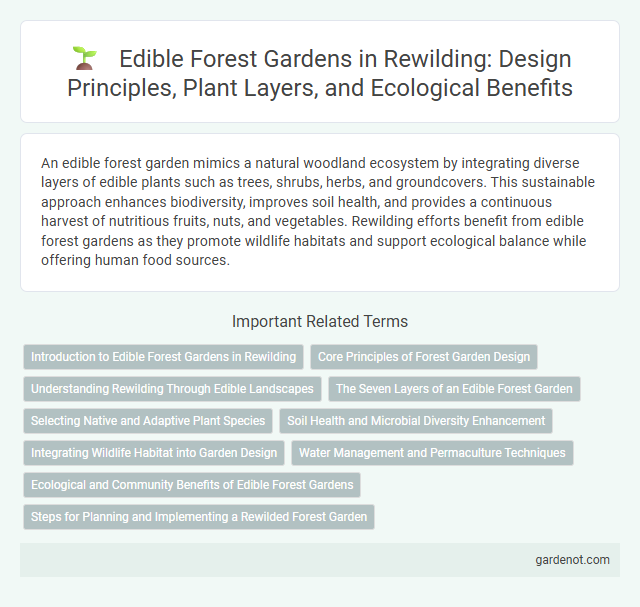An edible forest garden mimics a natural woodland ecosystem by integrating diverse layers of edible plants such as trees, shrubs, herbs, and groundcovers. This sustainable approach enhances biodiversity, improves soil health, and provides a continuous harvest of nutritious fruits, nuts, and vegetables. Rewilding efforts benefit from edible forest gardens as they promote wildlife habitats and support ecological balance while offering human food sources.
Introduction to Edible Forest Gardens in Rewilding
Edible forest gardens mimic natural ecosystems by integrating diverse layers of fruit and nut trees, shrubs, herbs, and perennial vegetables to create a self-sustaining food source that supports biodiversity. This rewilding technique enhances soil health, increases carbon sequestration, and provides habitat for pollinators and wildlife while producing nutritious yields. Implementing edible forest gardens restores ecological balance and promotes sustainable land use in rewilded landscapes.
Core Principles of Forest Garden Design
Edible forest gardens prioritize biodiversity by integrating layers of productive plants including canopy trees, shrubs, herbs, and ground covers to mimic natural forest ecosystems. Designing these gardens involves selecting species based on their mutual support, such as nitrogen-fixing plants to enhance soil fertility and deep-rooted trees to improve water retention. Proper spacing and succession planning ensure continuous harvest and resilience against pests while fostering ecological balance through creating habitats for pollinators and wildlife.
Understanding Rewilding Through Edible Landscapes
Edible forest gardens exemplify rewilding by mimicking natural ecosystems that produce diverse, sustainable food sources while enhancing biodiversity. These landscapes integrate perennial plants, nutrient-cycling trees, and habitat creation to restore ecological balance and offer resilient, low-maintenance agricultural systems. Understanding rewilding through edible landscapes highlights the synergy between food production and ecological restoration, promoting regenerative land stewardship.
The Seven Layers of an Edible Forest Garden
Edible forest gardens mimic natural ecosystems by incorporating the seven layers: canopy trees, low trees, shrubs, herbs, ground cover, root crops, and climbers, each providing diverse food sources while supporting biodiversity. Canopy trees like nut or fruit trees form the tallest layer, creating shade and shelter, while root crops such as garlic or carrots enrich soil health underground. This layered planting maximizes space, enhances soil fertility, and creates a resilient, self-sustaining system that mirrors native forest dynamics through strategic species selection.
Selecting Native and Adaptive Plant Species
Selecting native and adaptive plant species is crucial for establishing a resilient edible forest garden that supports local biodiversity and reduces maintenance needs. Native plants are well-suited to the local climate and soil conditions, enhancing ecosystem stability and attracting beneficial wildlife such as pollinators and natural pest controllers. Incorporating adaptive species with drought tolerance and disease resistance further ensures long-term productivity and sustainability in varied environmental conditions.
Soil Health and Microbial Diversity Enhancement
Edible forest gardens enhance soil health by promoting rich organic matter accumulation and maintaining natural nutrient cycles. Diverse plant species foster microbial diversity, supporting symbiotic relationships that improve nutrient uptake and disease resistance. This biodiversity boosts soil structure and fertility, creating a resilient ecosystem that sustains long-term productivity.
Integrating Wildlife Habitat into Garden Design
Edible forest gardens combine diverse layers of fruit and nut trees, shrubs, herbs, and groundcovers to create rich habitats that support local wildlife. Incorporating native plant species and natural water sources enhances biodiversity by attracting pollinators, birds, and beneficial insects. Designing garden elements to mimic natural forest structures promotes ecological balance while producing abundant food.
Water Management and Permaculture Techniques
Edible forest gardens utilize permaculture techniques such as swales and keyline design to effectively capture and manage water, reducing runoff and enhancing soil moisture retention. Deep-rooted plants and layered vegetation promote natural water filtration and prevent erosion, creating a self-sustaining ecosystem. These water management strategies increase resilience to drought while supporting diverse plant species and wildlife in rewilding projects.
Ecological and Community Benefits of Edible Forest Gardens
Edible forest gardens enhance biodiversity by mimicking natural ecosystems, supporting pollinators, and improving soil health through layered plant structures. These gardens provide sustainable food sources, reducing reliance on industrial agriculture while fostering local food security. Community involvement in edible forest gardening promotes environmental education, social cohesion, and shared stewardship of natural resources.
Steps for Planning and Implementing a Rewilded Forest Garden
Identify native and climate-adapted edible plant species to promote biodiversity and resilience in the edible forest garden. Design layered planting structures including canopy trees, shrubs, herbs, and ground covers to mimic natural forest ecosystems and enhance ecosystem services. Implement phased planting and maintenance schedules that emphasize natural regeneration, minimal intervention, and soil health to foster a self-sustaining rewilded environment.
Edible forest garden Infographic

 gardenot.com
gardenot.com